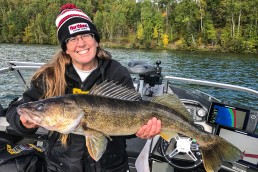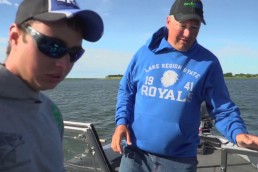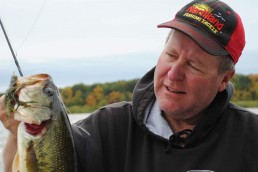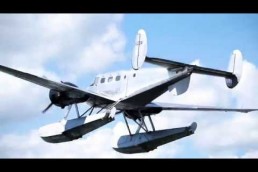Fall into Walleye Action
SHARE THIS POST
You don’t want to miss out on the fall walleye fishing action. Brian Brosdahl gives his expert advice on how to catch walleyes during fall.
Part of the reason many people like living in the North Country is the changing of seasons. Summer eventually has to come to an end, but that means my favorite season of the year is approaching, and good times are coming both in the woods and on the lakes.
The timing of when fall begins is hard to measure by the calendar. When I first moved “up north,” we would often get the first frost close to the end of August, but recently the first frost happens almost a month later, so the range of possibilities is pretty wide.
The bottom line, when it comes to the lakes, are the water temperatures, which determine most of the long-term patterns in the lakes. The summer fishing patterns will hold on as long as the surface water temperatures remain above 70 degrees.
Fall fishing patterns can have a few “false starts,” as short term weather patterns come and go late in the season. When the real fall cool-down begins, summer patterns fall apart pretty fast and the fish quickly start their fall migrations and put on the feedbag to get ready for winter.
Minnows and small fish have been hiding in the shallows much of the summer, growing quickly to get ready for their first winter under the ice. Sooner or later the water will begin to cool down and the smaller fish need to abandon the shallows, gather in larger schools and make their way into deeper water.
The move to deeper water puts minnows and smaller fish into harm’s way, which is right where the walleyes and other predator species want them. The main defense of the minnows, when they move deep, is they travel in large schools, so they can “hope” somebody else gets eaten instead of them. It’s all part of the natural process in a healthy self-sustaining lake or river system.
Everything is relative and depends on the size and dynamics of each lake. Some lakes are isolated and small, so the fall migration may just involve moving a few hundred feet into deeper water.
Large lake systems that are part of a chain of lakes or have a major river system connected to the lakes may have fish moving many miles between their summer haunts and their wintering locations.
Wherever and however the fish move in the fall, the one constant is food. The fish need to put on weight and add some fat before winter, and also need to fuel the development of their eggs and spawn, which start to form in the fall for spring spawning species of fish.
Access to deep water is a critical aspect of fall and winter locations for most species of fish. Fall fish migrations happen in predictable ways, so anglers that know where the fish have been, and where they are going, should be able to predict high traffic areas and potential feeding areas where migrating fish are likely pass through along the way to their winter locations.
Where walleyes go and what they do depends largely on the type of lake they live in, and what options they have for habitat. Walleyes in large shallow lakes that don’t experience thermocline during the summer will often move towards the shallows in the fall.
Are you enjoying this post?
You can be among the first to get the latest info on where to go, what to use and how to use it!
Walleyes in deep lakes usually move into deeper water in the fall, using complex structures that can provide all of their needs when the lakes eventually ice over for the winter.
I like to fish shallow water whenever possible, so I like to concentrate on the big shallow lakes early in the fall and then move to the deep lakes later in the fall, when the water temperatures cool into the 50s.
Big minnows are hard to beat in the fall for walleyes, because all the natural forage in the lakes has grown up during the summer. Walleyes are selective about the size baitfish they target, so I like to use large shiners, creek chubs or redtail chubs on live bait rigs.
I use a 3/8-ounce Northland Rock Runner slip sinker on a St. Croix seven-foot, six-inch Legend Elite medium action rod with an extra fast tip, with 10-pound test Sunline braid and a 6- to 8-pound test Sunline fluorocarbon leader. I like Gamakatsu circle hook for live bait rigging minnows, with a #4 hook for smaller minnows and a #2 hook for larger minnows.
Instead of setting the hook, I make sure the fish is swimming away from me and then do a speed reel with my rod tip down close to the water. When the rod loads up from the fish, I raise the rod tip and fight the fish. The walleyes are almost always hooked in the corner of the mouth.
I also use jigs in the fall. Actually, I use jigs all year long, even in the winter, but that’s a story for another day. My favorite jigging rod is a six foot, three inch St. Croix Legend Elite, with medium light action and a fast tip.
I use Sunline braided line on most of my rods, with a fluorocarbon leader on the end as a shock leader and also so walleyes don’t shy away from the braided line. I like 10 pound test green braid with an 8 pound test clear fluorocarbon leader for most situations.
I usually use 1/4- to 3/8-ounce jigs in the fall. I match the size jig with size minnow and also consider the depth, wind conditions and bottom type to select the right jig for the situation. .
I am hooked on my electronics. It feels like a confession, but I simply cannot stop and fish a spot when I am not seeing fish or at least seeing schools of baitfish on my Humminbird Helix 12 with Mega Side-Imaging.
I can see so much on the new G3 Humminbird units that I have complete confidence in my ability to find and see fish on sonar, as well as My Aqua-Vu HD 7 underwater camera which is critical to my guiding success for walleyes.
If the great walleye fishing was not enough in the fall, I also get to hunt and eat ruffed grouse, which is the “turf” part of my favorite surf and turf meals.
#Fall Walleye Fishing | #How to Catch Walleyes During Fall | #Brian Brosdahl Fishing | #Walleye Fishing in the Fall | #Big Fall Walleyes
MWO
SHARE THIS POST
Did you enjoy this post?
You can be among the first to get the latest info on where to go, what to use and how to use it!
Brian 'Bro' Brosdahl
Outdoor communicator Brian “Bro” Brosdahl lives in northern Minnesota. He is a walleye guide in the Cass Lake, Leech Lake and Lake Winnibigoshish areas. He is sponsored by Northland Fishing Tackle, Frabill/Plano, Aqua-Vu, Humminbird/Minn Kota, St. Croix Rods, Ranger Boats, and Evinrude. Guide inquiries: brosguideservice.com. Follow on social media.



